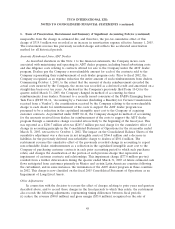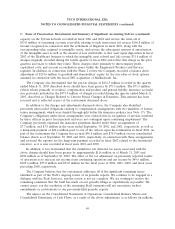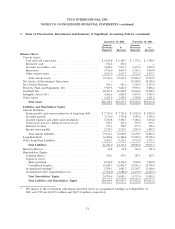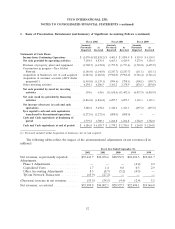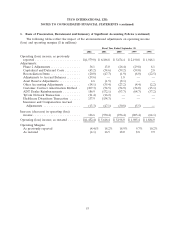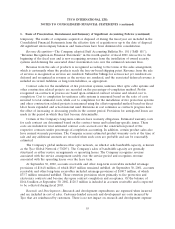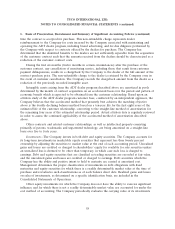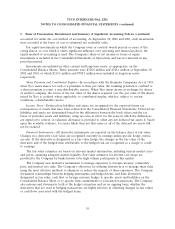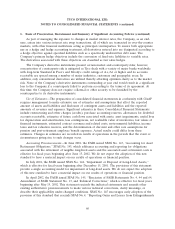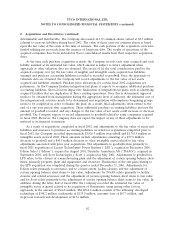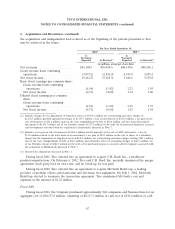ADT 2002 Annual Report Download - page 59
Download and view the complete annual report
Please find page 59 of the 2002 ADT annual report below. You can navigate through the pages in the report by either clicking on the pages listed below, or by using the keyword search tool below to find specific information within the annual report.TYCO INTERNATIONAL LTD.
NOTES TO CONSOLIDATED FINANCIAL STATEMENTS (continued)
1. Basis of Presentation, Restatement and Summary of Significant Accounting Policies (continued)
The Company generally divides its electronic security assets into various asset pools: internally
generated residential systems, internally generated commercial systems and customer accounts acquired
through the ADT dealer program. Subscriber systems represent internally generated residential systems
and internally generated commercial systems (customer accounts acquired through the ADT dealer
program are recorded as intangible assets). For internal purposes, we divide internally generated
commercial accounts into three smaller groups consisting of small business, core commercial and
national commercial accounts. The internally generated residential and commercial account pools are
generally amortized using the straight-line method over a ten-year period (a fourteen-year period for
national commercial accounts and a fourteen-year period with write-off of specific accounts upon
discontinuance for residential and commercial accounts in certain non-U.S. geographic locations).
The TGN is being constructed and is recorded at cost within the Consolidated Balance Sheets as
part of Tyco Global Network. When certain geographic segments of the TGN are completed and are
available for capacity sales, the costs of that segment are removed from construction in progress and
reclassified to placed in service. The portion of the TGN that has been placed in service is recorded
within the Consolidated Balance Sheet as Tyco Global Network—placed in service (see Note 26).
Gains and losses arising on the disposal of property, plant and equipment are included in the
Consolidated Statements of Operations and were not material.
Long-Lived Assets—The Company periodically evaluates the net realizable value of long-lived
assets, including property, plant and equipment and intangible assets, relying on a number of factors
including operating results, business plans, economic projections and anticipated future cash flows. An
impairment in the carrying value of an asset is recognized whenever anticipated future cash flows
(undiscounted) from an asset are estimated to be less than its carrying value. The amount of the
impairment recognized is the difference between the carrying value of the asset and its fair value.
Goodwill and Other Intangible Assets—Effective October 1, 2001, the beginning of Tyco’s fiscal year
2002, the Company adopted Statement of Financial Accounting Standards (‘‘SFAS’’) No. 142,
‘‘Goodwill and Other Intangible Assets,’’ under which goodwill is no longer amortized but instead is
assessed for impairment at least annually. Under the transition provisions of SFAS No. 142, there was
no goodwill impairment at October 1, 2001. Additionally, the Company has elected to make July 1 the
annual impairment assessment date for all reporting units, and will perform additional impairment tests
when triggering events occur. SFAS No. 142 defines a reporting unit as an operating segment or one
level below an operating segment. Our reporting units as of September 30, 2002 were as follows:
Security Services, Fire Protection, Electronics, Telecommunications, Healthcare, Plastics and Adhesives,
Flow Control, Electrical and Metal Products, and Tyco Infrastructure. See Note 16 for more
information on SFAS No. 142, and Note 11, ‘‘Discontinued Operations of Tyco Capital (CIT
Group Inc.),’’ for further information regarding the impairment of goodwill relating to Tyco Capital.
During fiscal 2001 and 2000, goodwill was amortized on a straight-line basis over periods ranging from
10 to 40 years. In accordance with the guidance of SFAS No. 142, goodwill associated with acquisitions
consummated after June 30, 2001 was not amortized during the fourth quarter of fiscal 2001.
Intangible assets primarily include contracts and related customer relationships, and intellectual
property. Certain contracts and related customer relationships result from the Company purchasing
residential monitoring contracts from an external network of independent dealers who operate under
the ADT dealer program. Each acquired contract and related customer relationship is recorded at its
contractually determined purchase price, net of a non-refundable amount charged to dealers at the
57



